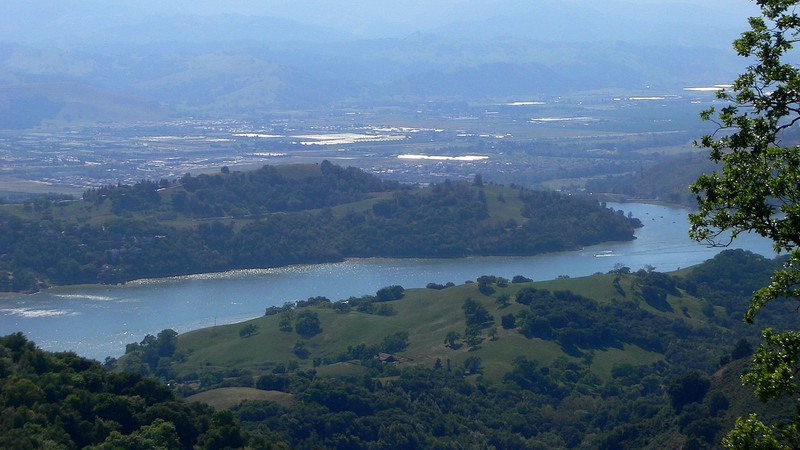
Anderson Reservoir will be dry for 10 years due to a seismic retrofitting project. Tom Pavel / Wikimedia Commons C.C. 2.0 License
Just one day before Governor Gavin Newsom asked Californians to cut back their water use by 15 percent from 2020 levels, to cope with drought conditions that are getting worse each year, Santa Clara County officially began work on a project that will leave the largest of Santa Clara Valley Water District's 10 reservoirs dry for the next decade.
The project, which will create a 1,700-foot outlet tunnel next to Anderson Dam in Morgan Hill, is part of a larger seismic retrofit of the dam and the 89,703 acre-foot capacity Anderson Reservoir. The dam reconstruction, officials say, is needed to prevent a potentially catastrophic flood in the event of a serious earthquake that strikes the dam.
Anderson Reservoir, prior to being drained as part of the retrofit project, was using only three percent of its capacity, in order to minimize flooding dangers. The 10-year project—the first three years of which will be devoted to building the new tunnel—is designed to allow the reservoir to safely resume its full capacity.
At the ceremonial groundbreaking for the tunnel project on July 7, Congressional rep Zoe Lofgren, a former Santa Clara County supervisor, said that in its current state the dam could unleash a “wall of water” that would submerge all of Morgan Hill is under 15 minutes, according to a report by Michael Moore of the Gilroy Disptach.
“Not only would this flood parts of San Jose, in a major event it would flood all the way up to…the San Francisco Bay,” Lofgren said, as quoted in the Dispatch. It floods all the way through the Pajaro (River) from the Monterey Bay.”
Back in 2009, the Santa Clara Valley Water District issued a study finding that a 6.6 earthquake under the reservoir, or a 7.2 temblor up to two miles away, could send a 35-foot wall of water rushing toward Morgan Hill, flooding a huge portion of the valley within two hours. Keeping the water level in the reservoir low enough that it would not spill over the top of an earthquake-damaged dam prevents a disaster of those apocalyptic proportions.
A single acre-foot of water is equivalent to 325,851 gallons, or enough to supply two households of five people each for one year, according to the water district, which is generally referred to as Valley Water.
Once the retrofit is completed, maintaining a lower water level in the reservoir will no longer be necessary, according to the plan.
“The citizens of Morgan Hill have had to live in the shadow of a potential disaster—not just for Morgan Hill but for the entire Santa Clara County,” said Morgan Hill Mayor Rich Constantine at the groundbreaking ceremony, as quoted by the Dispatch. “So the fact that we are here today having a groundbreaking on a 10-year project is monumental.”
On July 8, Newsom expanded his drought emergency declaration to 50 of the state’s 58 counties, covering 42 percent of California’s population, according to a Los Angeles Times report. But he did not issue any order or mandate for residents to reduce their water consumption, despite asking Californians for a 15 percent cutback.
“We’re not trying to be oppressive,” the governor said. “These are voluntary standards.”
Short articles summarizing reporting by local news sources with linkbacks to the original content.